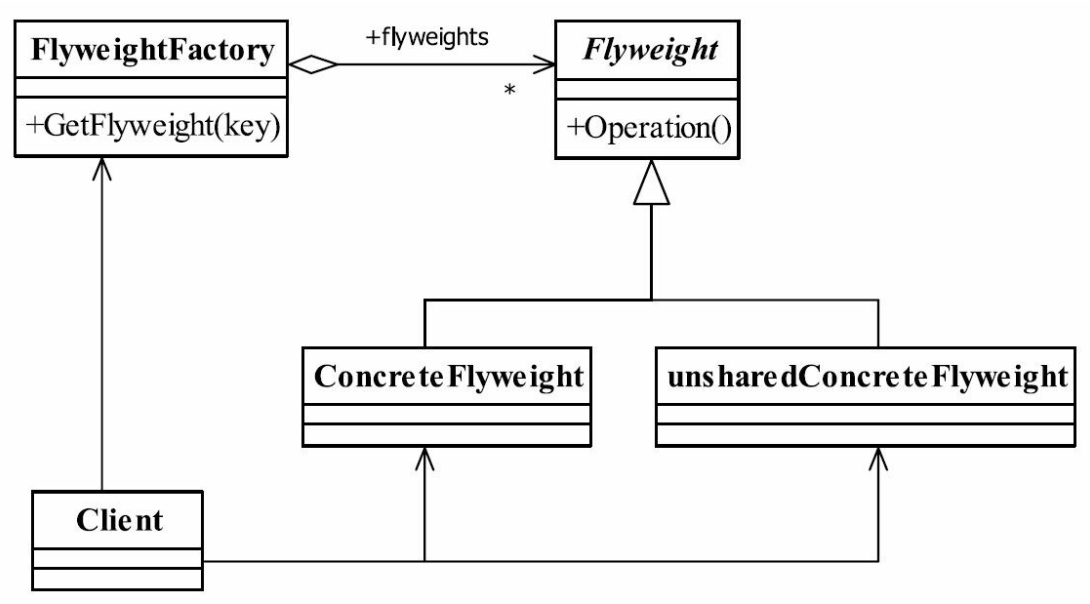哈喽,大家好,我是指北君。
相信大家日常开发过程中,一个优秀的程序猿写出的代码一定要节省空间的,比如节省内存,节省磁盘等等。那么如何通过设计模式来节省内存呢?
1、什么是享元模式?
Use sharing to support large numbers of fine-grained objects efficiently.
享元模式(Flyweight Pattern):使用共享对象可有效地支持大量的细粒度的对象。
说人话:复用对象,节省内存。
2、享元模式定义

①、Flyweight——抽象享元角色
是一个产品的抽象类, 同时定义出对象的外部状态和内部状态的接口或实现。
一个对象信息可以分为内部状态和外部状态。
内部状态:对象可共享出来的信息, 存储在享元对象内部并且不会随环境改变而改变,可以作为一个对象的动态附加信息, 不必直接储存在具体某个对象中, 属于可以共享的部分。
外部状态:对象得以依赖的一个标记, 是随环境改变而改变的、 不可以共享的状态。
②、ConcreteFlyweight——具体享元角色
具体的一个产品类, 实现抽象角色定义的业务。 该角色中需要注意的是内部状态处理应该与环境无关, 不应该出现一个操作改变了内部状态, 同时修改了外部状态, 这是绝对不允许的。
③、unsharedConcreteFlyweight——不可共享的享元角色
不存在外部状态或者安全要求(如线程安全) 不能够使用共享技术的对象, 该对象一般不会出现在享元工厂中。
④、FlyweightFactory——享元工厂
职责非常简单, 就是构造一个池容器, 同时提供从池中获得对象的方法。
3、享元模式通用代码
1 | |
1 | |
1 | |
1 | |
4、通过享元设计文本编辑器
假设文本编辑器只包含文字编辑功能,而且只记录文字和格式两部分信息,其中格式包括文字的字体型号、大小、颜色等信息。
4.1 普通实现
通常设计是把每个文字看成一个单独对象。
1 | |
1 | |
客户端:
1 | |
4.2 享元模式改写
上面的问题很容易发现,每一个字符就会创建一个 Character 对象,如果是几百万个字符,那内存中就会存在几百万的对象,那怎么去节省这些内存呢?
其实,分析一下,对于字体的格式,通常不会有很多,于是我们可以把字体格式设置为享元,也就是上面说的可以共享的内部状态。
内部状态(共享):字体类型、大小、颜色
外部状态(不共享):字符
于是代码改写如下:
1 | |
1 | |
1 | |
1 | |
5、享元模式在 java.lang.Integer 中应用
看下面这段代码,打印结果是啥?
1 | |

为什么是这种结果呢?
首先说一下 Integer i = 59;底层执行了:Integer i = Integer.valueOf(59); 这是自动装箱。
int j = i; 底层执行了:int j = i.intValue(); 这是自动拆箱。
然后我们Integer.valueOf() 方法:

再看 IntegerCache 源码:
1 | |
其实这就是我们前面说的享元对象的工厂类,缓存 -128 到 127 之间的整型值,这是最常用的一部分整型值,当然JDK 也提供了方法来让我们可以自定义缓存的最大值。
6、享元模式优点
减少应用程序创建的对象, 降低程序内存的占用, 增强程序的性能。
但它同时也提高了系统复杂性, 需要分离出外部状态和内部状态, 而且外部状态具有固化特性, 不应该随内部状态改变而改变, 否则导致系统的逻辑混乱。
7、享元模式应用场景
①、系统中存在大量的相似对象。
②、细粒度的对象都具备较接近的外部状态, 而且内部状态与环境无关, 也就是说对象没有特定身份。
③、需要缓冲池的场景。
